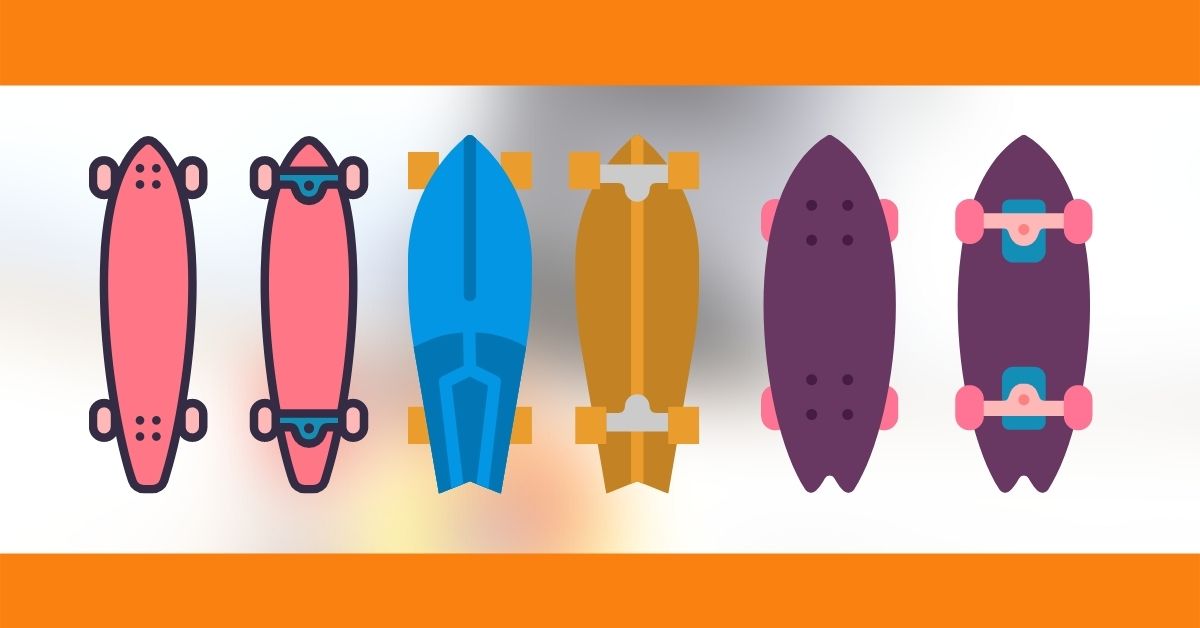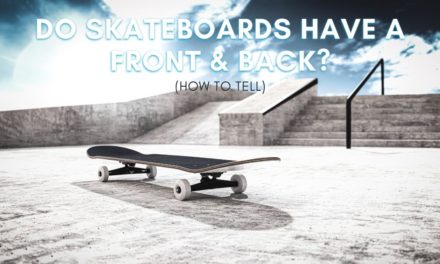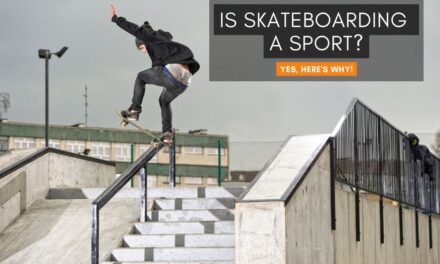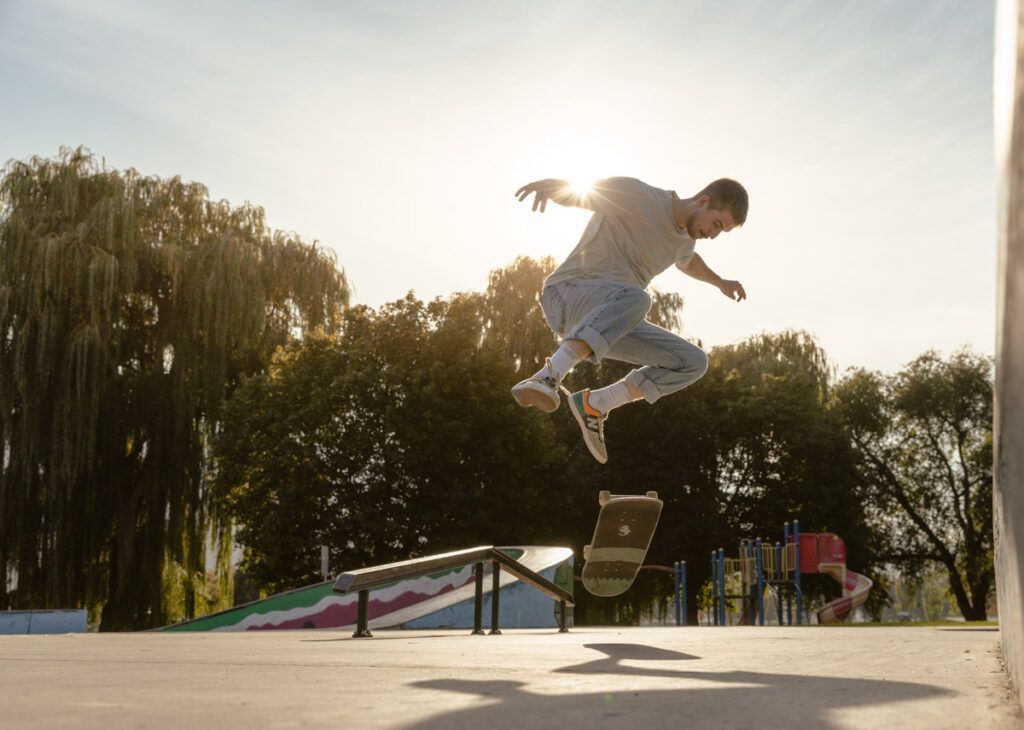If you’re skating a cruiser board, you’ve likely noticed how few people ride them at the skatepark, let alone do tricks on them. It’s pretty common to assume that cruiser boards simply aren’t meant for tricks, but I’m here to tell you that’s not the case. Even if you’re a complete beginner, there are a handful of easy tricks you can do on any cruiser board, right now.
The easiest tricks to learn on a cruiser board are:
- Manuals
- 180 Body Varials
- Hippie Jumps
- Flip On
- Powerslides
- Shuv-its
- Front Shuv-its
- Nollie Shuv-its
- Nollie Front Shuv-its
- Ollies
These tricks above are in order from easiest to hardest, even you’re relatively new to skateboarding and cruising. I’ll break down exactly how to do these tricks later in this post, but first, let’s break down the reasons why you don’t see as many people doing tricks on cruiser boards.
Is it harder?
Can you do the same tricks?
Well, let’s find out.
Is It Harder To Do Tricks On A Cruiser Than A Skateboard?
You can do all the same tricks on a cruiser board as you can on a regular skateboard. However, many people find cruiser boards more difficult because of their flat deck shape and overall size. Although it is still possible to do tricks on a cruiser, it is less beginner-friendly.
A regular skateboard has an even width stretching between the nose and tail, giving you more room to slide your feet or flick tricks. On a cruiser board, the shape varies but is rarely an even width.
Some cruiser boards are narrow in the tail but wide in the nose, are very narrow in just the nose and tail, or a mixture of something in between. This means every board takes some getting used to before it feels “normal” to do a trick with. Since standard skateboards all have a similar shape, it’s a similar feeling to do tricks on any board you use.
To add to this, cruiser skateboards don’t often have as much concave as a standard skateboard deck. You can see the concave on a normal skateboard by looking at the top of the deck to see how the outsides curve upwards from the center slightly. On a cruiser board, this concave is more minimal, or completely non-existent.
Concave helps to flick and catch tricks you do, and it’s definitely noticeable when you suddenly don’t have it. If you’ve never done tricks on a normal skateboard, you won’t notice the difference. However, if you’re switching over to a cruiser board, the lack of concave will take some getting used to.
The final reason cruisers are harder to do tricks on is that their size is often much larger or much smaller than a standard skateboard.
The average skateboard deck most people skate for tricks has a 7.75″ – 8.5″ with a 32″ length. Compare that to a cruiser board which varies between under 6″ wide, and over 9.5″ wide with lengths varying between 25″ to 32″ and you can see how it’s a totally different skating experience.
Luckily, even though it’s slightly more difficult overall to do tricks on a cruiser, there are a handful of tricks that are super easy to do still, even if you’re a beginner.
10 Easy Tricks You Can Do On A Cruiser Skateboard
Many of the trick tip videos below are taught with a standard skateboard deck, but the same techniques apply when skating a cruiser board.
1. Powerslide (Frontside & Backside)
A powerslide is when you shift your weight to the heel or toe edge of your board while kicking out your back foot to slide the wheels horizontally along the ground. This is a trick that’s a go-to for anyone who skates cruisers and is a ton of fun since it can be done on any skateboard. If you have softer wheels like 78a for example, they will be harder to do, but still possible with enough effort to slide your wheels.
The first thing to do when doing a powerslide is to get your stance right. By placing your feet wider apart (such as over the bolts at the nose and tail) it’s easier to balance as you slide.
Next, weight your toe edge (frontside) or your heel edge (backside) and kick out your back foot as if you’re trying to pivot the board all in one movement. With your weight heavily on the one side of your board, your weight will overcome the friction of your wheels and your board will start to slide.
Then by reducing the force your putting on either side of your board, your board will somewhat correct itself back into its normal position. However, sliding your back foot around helps with this process.
2. Shuv-It
A shuv-it is another easy trick to do on your cruiser board, which essentially rotates your board 180° under your feet. The trick to this is to isolate the movement to your back foot rather than kicking your front foot outwards.
With your front foot over or near the bolts, and your back foot high on the tail, do a small jump to lift your body weight, then kick your back foot and the tail behind you. Once the board is fully rotated, try to catch it with your front foot, or just land with both feet for simplicity at the beginning.
A common thing you’ll find with this trick is that the board ends up slightly in front of where you started the trick. By jumping forward in anticipation of the landing, I’ve found this to make shuv-its slightly easier.
3. Front Shuv-It
A front shuv-it is similar to a regular shuv-it, except now rotating 180° in the opposite direction. The foot placement for this trick is slightly different as well, which is important to note if you want to land this trick easily.
For your back foot, place it in the pocket of your tail, which is at the bottom of your tail. Placing the balls of your feet here will help with pushing your tail forward without the board flipping accidentally.
As for your front foot, place it just behind the front bolts with your toes hanging off the edge. This helps to guide the board when it first starts to rotate.
Now just like a shuv-it, jump slightly to lift your weight off the board while simultaneously pushing your tail forward with your back foot. Isolating the movement to your back foot will help with getting a clean rotation for this trick.
With front-shuvs, the board tends to land slightly behind you, so jumping backward as you pop makes it a lot easier to land the trick in my experience.
4. Nollie Shuv-It
Continuing the chain of shuv-it tricks, comes the nollie shuv which is a shuv-it, except done off the nose of your skateboard. The setup for this trick is the same as a regular shuv, except with your front foot on the nose of your skateboard, and your back foot near the bolts by the tail.
Jump slightly to lift your weight while scooping your nose behind you with your front foot. At first, it can help to also kick your back foot slightly forward to help with the rotation of the board.
The only problem with nollie tricks is that your cruiser needs to have a bit of a nose. If your cruiser doesn’t have much deck extending past the front trucks, these tricks become more difficult with less leverage on the nose.
5. Nollie Front Shuv-It
Nollie front shuvs are the opposite of a nollie shuv, this time pushing the board forward with your front foot on the nose, rather than behind you. For this trick, it’s easiest to place the balls of your feet near the heel edge of your nose, aka in the pocket. As for your back foot, I find it easiest to place it just beneath the bolts near my tail, with your toes slightly overhanging from the toe edge.
Then by slightly jumping while pushing your front foot forward on the nose, your board will rotate under your feet. This trick often will land slightly behind you like a regular front shuv will do, so jumping back a bit before you land will help you stay more consistent.
6. Ollie
An ollie of the most common trick for skateboarding since it’s the foundation of just about any trick you pop. Whether you’re skating on a cruiser or not, the same principles apply to this trick.
Placing your back foot on the tail and your front foot just below your front bolts, jump and press down your tail to hit the ground. When your tail hits the ground, this creates pop to lift your rear wheels slightly off the ground. At the same time you pop, slide your front foot upwards on your skateboard to lift it off of the ground. Sucking your legs up to your chest will help to create a higher ollie, but ultimately it takes some practice to get right.
7. Manuals
Manuals are done by balancing on your rear wheels while your front wheels are off the ground. You can also do this trick off of the nose as well (a nose manual), but this is usually more challenging.
To get into a manual, place your back foot on the tail with your front foot somewhere near the front bolts. A wider stance will help you feel more secure while you manual, so I often keep my front foot over the front bolts for better balance.
Now to get into the manual, simply weight your back foot while reducing the weight on your font foot to lift up your nose. Keeping your knees bent, try to find the “sweet spot” where you can stay balanced on your rear wheels. It’s super common to go a bit too far and drag your tail, or for your front wheels to go back to the ground.
Just keep with it since it’s all about improving your balance. As you get more comfortable with the feeling of a manual, you’ll be able to hold it for longer.
A great starting point to practice this trick is to manual between cracks in the sidewalk!
8. Hippie Jumps
A hippie jump is when you jump over an obstacle, while your board rolls underneath it. At first, this trick feels intimidating, but if you just commit to landing on your board, it’s actually pretty easy. A great place to try them is over a flat bar at your local skatepark.
To do a hippie jump, roll up to an obstacle with enough speed to get you and your board past it. Right as you’re about to make contact with the obstacle, jump straight up and lift your feet high enough to clear the obstacle, then land back on your board to roll away.
9. Flip On
A flip-on is a stationary trick that starts with your board upside down on the ground (wheels up), and your toes underneath the deck. In one movement, jump up and forward while keeping your feet rigid to flip your board the right way around. This will flip your board back onto its wheels and you’ll find yourself standing on top of it when you land!
This was one of the first tricks I ever learned on a cruiser board when I was a kid, but it still feels just as satisfying today.
10. 180 Body Varial
A 180 body varial is done by jumping up off your skateboard and rotating your body 180° before landing back on it. This trick is best learned while stationary, but once you feel comfortable, try it moving too. You can spice up this trick with other ones such as the 180 hippie jump, or the ollie body varial.
It all starts with a stationary hop and spin though!
So that was 10 beginner-friendly tricks to try on a cruiser skateboard with tricks to try even if it’s your first-day skating. Cruiser boards are a ton of fun to do basic tricks with and offer a more smooth rolling and “flowy” experience than skating on a regular skateboard.
If you primarily use your cruiser board for getting around town and commuting, having the right set of wheels makes the ride way more enjoyable. I share 12 of my favorite wheels for cruiser boards here to help you find the right set!
Happy Shredding!
Brendan 🙂






